The World Is More Fragmented, but Interdependence Still Rules
After two and a half years of a pandemic that has exposed the fragility of global supply chains and eight months of war in Ukraine that has severed economic ties between Russia and the West and disrupted global food and energy markets, the world seems to be at a turning point. Globalization, many claim, is receding. A growing number of analysts now argue that much as World War I and the 1918 influenza pandemic brought an end to the first great era of globalization, the combination of Russia’s war in Ukraine, COVID-19, simmering populism, and geopolitical competition between the United States and China has kicked the second great era of globalization into reverse. “This new cold war marks the end of the era of globalization and integration that has shaped the international system since 1989,” the journalist Fareed Zakaria wrote in mid-October.
Prominent investors and policymakers agree. Larry Fink, the CEO of the asset management firm BlackRock, wrote to shareholders in March that the war in Ukraine had “put an end to the globalization we have experienced over the last three decades.” And at the World Economic Forum in Davos in May, International Monetary Fund Managing Director Kristalina Georgieva warned of a coming “geoeconomic fragmentation.” Countries and companies, she said, are “re-evaluating global supply chains” and undoing decades of integration.
Yet globalization has been pronounced dead many times before: after the global financial crisis in 2008, after the Brexit referendum in 2016 and the election of Donald Trump later that year, and after the outbreak of the COVID-19 pandemic in 2020. That none of these predictions has come to pass should give analysts pause about predicting deglobalization once more. Rather than the end of economic integration, the world is experiencing a geopolitical recession that has left globalization adrift.
MORE INTERCONNECTED THAN EVER
Those proclaiming the demise of globalization as it was once known are not totally wrong. It is true that the era of “hyperglobalization” that lasted from the 1970s to the 2008 global financial crisis, during which a hegemonic United States drove a top-down process of trade liberalization and global integration, was a unique historical episode. That era is now dead and buried along with globalism, the ideology that propelled it, and unipolarity, the international order that upheld it.
An increasingly inward-looking United States no longer has the political will to serve as architect and guarantor of the world economy. China, meanwhile, is beset with structural economic challenges that limit its ability to promote its own order by means of trade access and investment policy. And no other country or group of countries has the capacity to fill the void.
But that does not mean that globalization is ending. Such an outcome would require the United States to actively turn against economic integration. Bombast aside, that did not happen under Trump, and it is not happening under U.S. President Joe Biden. Rather, the United States has simply stopped leading the drive for ever-greater globalization. This leadership vacuum has resulted in the fraying of the “governance of globalization,” as the former World Bank President Robert Zoellick has put it. But globalization itself is not fraying—it is simply adrift. It is less coordinated, deliberate, and efficient than before but still in most countries’ interest given how much worse the alternatives are.
A look at economic data belies the notion that globalization is reversing. Even as global capital flows relative to GDP have moderated since their peak in the middle of the first decade of this century, cross-border investment has continued to grow and financial market returns have remained highly correlated globally. Worldwide merchandise trade is near all-time highs, having surpassed pre-pandemic projections already this year. Multilateral trade negotiations have stalled, but new trade deals continue to emerge, including the Regional Comprehensive Economic Partnership between 15 Asia-Pacific nations and the 11-member Comprehensive and Progressive Agreement for Trans-Pacific Partnership. The number of regional trade agreements in force has grown continuously since the 1990s, more than doubling since 2008.
The world is experiencing a geopolitical recession that has left globalization adrift.
Trade in goods has slowed relative to global output since 2008, but even this shift does not signal deglobalization. To the contrary, the plateauing of the global trade ratio is partly a side effect of economic development—a sign of globalization’s success. Take the example of China, which has seen its ratio of trade to GDP decline by nearly 30 percentage points since 2006 and which, by virtue of its size, has been the biggest contributor to the slowing worldwide trade-to-GDP ratio. As the country has grown richer and its economy more complex—owing to market reforms and integration into global markets—China’s growth model has shifted away from exports and toward domestic consumption and investment. At the same time, domestic demand has shifted away from goods and toward services, which are traditionally less tradable. China has also moved up the value chain, manufacturing fewer cheap consumer goods and more advanced intermediate inputs, and now produces a greater share of the value of its exports domestically. Because of rising incomes, Chinese labor is more expensive as well, making the country a less desirable manufacturing hub and eliminating one of the country’s key competitive advantages. And finally, China has already exploited and exhausted most opportunities for trade liberalization and integration into global value chains, meaning that it has less room to globalize further.
None of these trends constitute disintegration or retrenchment. Rather, they reflect the fact that globalization has diminishing returns, and not just for China. Now that most countries are already relatively well integrated into the global economy, the world as a whole has less to gain from additional globalization. In general, as once closed low-income economies integrate into global markets and grow wealthier and more developed, they become more self-sufficient. China and many other emerging-market countries that globalized in the last half century now produce more of what they consume, consume more of what they produce, and produce more of what they produce. This shows up in the data as a decline in global trade intensity, but it is a sign of progress, not of deglobalization.
What is more, technological advances such as e-commerce, automation, artificial intelligence, robotics, cloud computing, and telework have transformed many labor-intensive production processes into capital- and knowledge-intensive processes. Trade designed to take advantage of labor-cost differentials between countries has consequently declined worldwide—but not because of any conscious turn against globalization.
The growing importance of services and intangibles in the modern economy has also fueled the false impression of deglobalization. Trade in services and intangibles has been accelerating for 15 years and accounts for an increasingly large share of global economic activity. This is especially true of trade in digital services. For instance, computer and communication services now make up around half of all services exports and three percent of global GDP. Intangibles such as research and development, intellectual property rights, branding, design, and software have also grown significantly as a share of total trade, investment, and output. Yet many services and intangibles are not captured by current trade data because of measurement challenges.
All this suggests that traditional measures of globalization are being rendered obsolete as the global economy grows more complex. In reality, however, the world is more interconnected than ever. And interconnection begets interconnection, because the more interconnected nations grow, the harder and costlier it becomes for them to decouple.
DECOUPLED, NOT DIVORCED
To be sure, parts of the world are decoupling, but only some parts and only to some extent. Advanced industrial democracies are forcibly decoupling from Russia in a way that is near-total and likely permanent. Western multinational companies have closed nearly all their businesses in Russia and liquidated their holdings. Russian oligarchs have been sanctioned and their assets have been frozen. Most Russian banks have been banished from SWIFT, the global payments system, and even Russia’s central bank reserves have been seized. The developed world is halting its purchases of Russian energy and blocking Russia’s access to advanced manufactured goods and critical components.
This decoupling will have dire implications for Russia’s economic, military, and geopolitical standing. But Russia is hardly being cut off from the entire world. Although the country accounts for a minuscule share of world GDP, its natural resources are too valuable for it to be cut off entirely from the global economy. China and India have already increased their purchases of Russian oil from a combined 1.7 million barrels per day in June 2021 to nearly 2.8 million barrels per day in June 2022, and at a discount. Developing countries still rely on Russian grain and fertilizer, and many regular and irregular armies continue to use Russian weapons and mercenaries. Much of the world will continue to do business with Russia.
The United States and China, meanwhile, are locked in an intensifying geopolitical competition that has led them to decouple in areas perceived to be of national security importance. These areas encompass an ever-growing number of “strategic” sectors—from dual-use technologies such as semiconductors to renewable energy to social media and other information industries—that are now off-limits for foreign trade and investment.
But this partial decoupling can only go so far because the U.S. and Chinese economies are so interdependent that a full divorce would be ruinous for both countries and for the world. The U.S. and Chinese business communities want to do more, not less, business with each other. Likewise, most other countries—including the United States’ closest allies in Asia and Europe, which are just as wary of China’s rise—have no interest in mutually (and globally) assured economic destruction and are therefore ramping up investment in and exposure to both the U.S. and Chinese economies.
The U.S. and Chinese business communities want to do more, not less, business with each other.
Despite tensions, trade wars, and pandemic disruptions, bilateral trade between the United States and China has continued to grow. Two-way goods trade stood at $657 billion in 2021, up from $557 billion in 2019, and this year’s figure will almost surely surpass the record of $659 billion set in 2018. The United States is still China’s largest goods trading partner and export market, and China is still the United States’ largest goods trading partner, its largest supplier of imported goods, and its third-largest export market.
Investment has also remained strong. Although Western corporations are more worried about the risk of investing in China than they were in the past, they show few signs of backing off. Foreign direct investment into China reached a record high last year, and a recent survey by the American Chamber of Commerce in China found that 83 percent of American manufacturers operating there have no plans to move out. Only three percent intended to “reshore” production to the United States and 60 percent planned to increase their investment in China. U.S. imports of intermediate and final manufactured goods continue to grow faster than U.S. manufacturing output, indicating that no net reshoring has occurred so far.
For its part, Beijing might like to become technologically and economically self-reliant, but China’s economic growth remains dependent on commercial ties with the West. Together, the United States, the European Union, and Japan buy nearly 40 percent of China’s exports—a share that has barely budged in the last decade. Moreover, China lacks the ability to produce cutting-edge semiconductors indigenously, and U.S. export controls and investment restrictions ensure that it will remain unable to produce them for at least the next decade. Given the importance of semiconductors for manufacturing not just consumer goods such as phones, computers, and cars but also most advanced weapons systems, China simply cannot afford to decouple from the United States and its allies.
That is not to say the United States and China are growing closer. The most important geopolitical relationship in the world is still entirely devoid of trust, and the domestic politics of both countries lean increasingly toward antagonism. Bipartisan U.S. hostility toward China, Chinese “Wolf Warrior” diplomacy, the politics of the pandemic, Russia’s invasion of Ukraine, and rising tensions over Taiwan have all made the U.S.-Chinese relationship more dangerous and harder to manage. But the relationship is not on the verge of breaking down, because the ties that bind the two countries are becoming more, not less, important.
LEADERLESS WORLD
Although the partial decoupling of Russia and the West and China and the United States does not amount to deglobalization, it does indicate a shift in the nature of globalization. The global economic order is becoming more multipolar and fragmented in the absence of international leadership. This means that geopolitics will increasingly creep into economic calculations. The interdependencies and vulnerabilities exposed by COVID-19 and Russia’s invasion of Ukraine have brought economic security concerns to the fore. Countries and companies will increasingly attempt to make themselves more resilient to external shocks and insulate themselves from geoeconomic pressures through a combination of “ally shoring,” “nearshoring,” diversifying supply sources, and stockpiling. It is even possible that cross-border economic activity will splinter into geopolitical spheres of influence, as countries deepen their integration with friends and reduce their reliance on foes.
These forces point away from the aggressive globalization of recent decades, but not toward autarky. The benefits of scale and specialization are too great, and the costs of reversing globalization are too high. The global value chains that produce most modern goods are so complex and spread out that recreating them at a national level is virtually impossible. Western companies will increasingly pull back from China, no doubt, but for the most part they won’t bring production back home, instead shifting it to friendly, lower-wage nations such as Mexico and Vietnam. With few exceptions, reshoring and insourcing would prove excessively costly—and risky. As the shortage of baby formula in the United States demonstrated earlier this year, resilience is best achieved through diversification and spare capacity—not self-reliance.
These shifts in the patterns of global integration may well result in efficiency losses. Politics and geopolitics, after all, increase transaction costs and impede the optimal allocation of resources. But this is a small price to pay to ensure that globalization and its benefits endure. Striking the right balance between efficiency and security will result in a safer, more sustainable economic order.
 Eurasia Press & News
Eurasia Press & News




